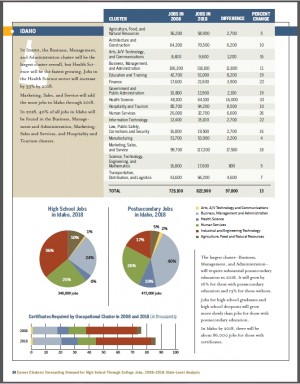Idaho Poised to Lead the Nation in Medical Job Growth
A recent study finds Idaho will lead the nation in the creation of new jobs in the health sciences sector. Georgetown University’s Center on Education and the Workforce published this study earlier this month. The report forecasts job demand. More specifically, it looks at the kinds of jobs that will be available for high school graduates, college grads and those with advanced degrees.
Here’s an excerpt from the study:
The key for students, workers, job counselors and educators will be knowing where to find these opportunities and then matching the right job with the right applicant. That is where this report can help. In the full version of the report, we present forecasts on job opportunities and skill requirements through 2018, broken down by the 16 career and technical education (CTE) clusters by the Carl D. Perkins Act of 2006. The Perkins Act is a federal program aimed at improving technical education in the United States, and its clusters are widely used by vocational programs and counselors to assist students in preparing for and then finding jobs. Using our forecasts, we identify the most promising clusters for three categories of job seekers. Those are workers with:
- High School Jobs: For those with a high school diploma or less.
- Middle skill jobs: For those with some college but no degree (including postsecondary vocational certificates) or an Associate’s degree.
- BA plus jobs: For those with a Bachelor’s degree or better.
The forecast is from 2008 through 2018. It estimates that by 2018, jobs in Idaho’s health sciences sector will have seen a 33 percent increase, growing faster than any other sector in the state. The four other states projected to lead job creation in health sciences are; Nevada, Utah, Colorado and Texas.
The study indicates that Idaho’s economy will also build on familiar strengths. The state is projected to lead the nation in the share of jobs in the agriculture, food and natural resource sectors by 2018. (So are Wyoming, North Dakota, Arkansas and South Dakota). Ag and natural resources have long been staples of Idaho’s economy.
Jay O’Laughlin is the director of the Idaho Forest Wildlife and Range Policy Analysis Group at the College of Natural Resources, University of Idaho. “The key thing here is that our natural resource industries in the state are poised to help lead Idaho into the future,” O’Laughlin said.
Still, the report forecasts it will be Idaho’s business, management and administration sectors that will make up the largest share of jobs in the Gem State. Those jobs will require a substantial amount of education after high school. And jobs in the marketing, sales and service industries will add the most jobs through 2018.
Here are some other interesting facts from the study:
- Thirty-seven percent of all jobs in 2011 will be for workers who have either a high school diploma or incomplete high school education with some on-the-job training. This number is down from 72 percent in 1973, 44 percent in 1992, and 41 percent in 2007.
- Better-paying opportunities for workers with high school diplomas or less are in male-dominated fields. More than 80 percent of the workforce in manufacturing; architecture and construction; and transportation, distribution, and logistics is male.
- In 2018, 40 percent of all jobs in Idaho will be found in the business, management and administration, marketing, sales and services, and hospitality and tourism clusters.





